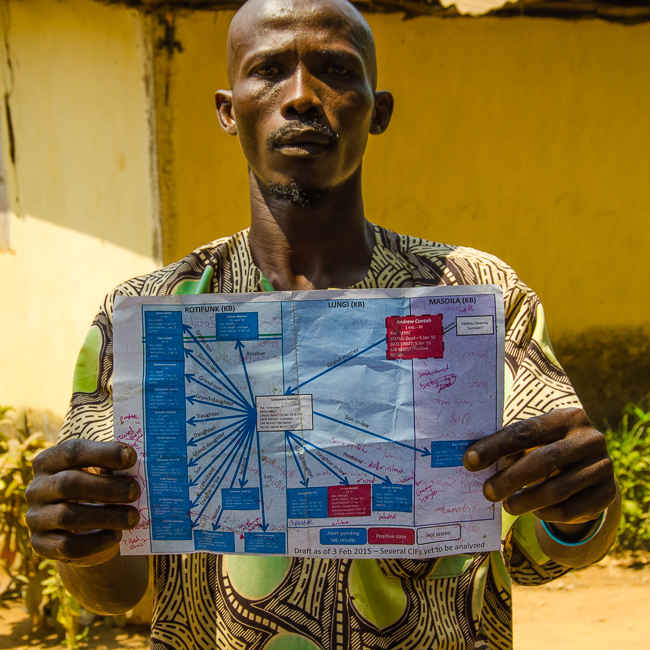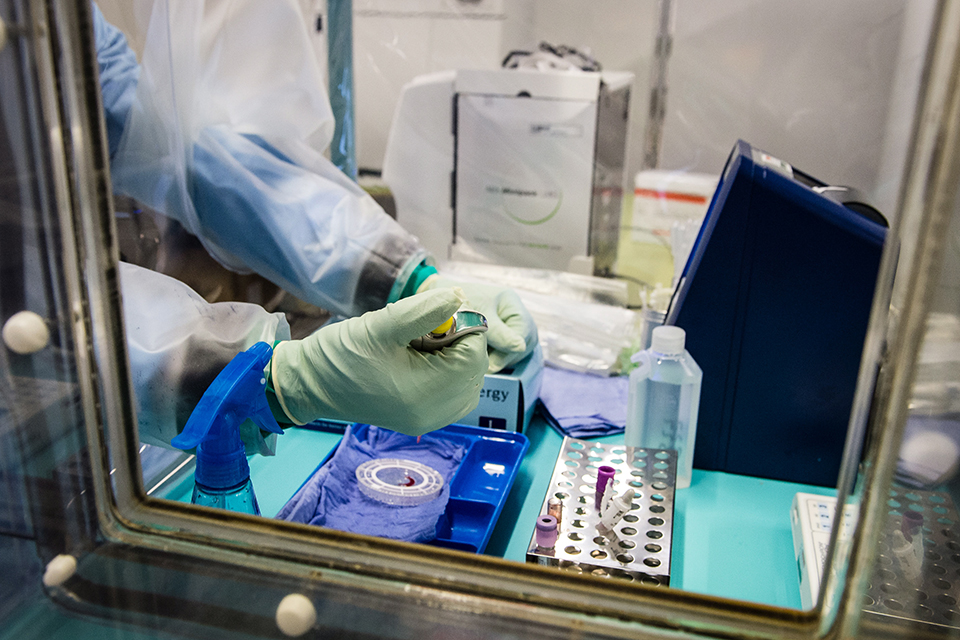
Bounding through a thicket and sweating underneath an impermeable biohazard suit, the village headman chased a woman he suspected had Ebola. She dashed away. Her daughter had recently died of Ebola at a hospital, and she feared the headman would ship her to the hospital, where a malevolent force might cause her to suffer the same fate.
Indeed, Ebola response workers did intend to isolate the woman. In quarantine, they'd monitor her for symptoms of the deadly disease and, if signs surfaced, hospitalize her.
Since the day the woman ran away, several people in Tigbonor, a village in Sierra Leone, had spotted her under the shroud of darkness. "At 2 a.m., the woman sneaks chop," or food, says N'Baimba Conteh, the headman. But she always escapes before he can don his protective gear and catch her.
The woman's speed and cunning prompt some villagers to suspect supernatural abilities. After wavering on whether he thinks she has mystical prowess, Conteh simply says, "I'm fed up."
I ask if his people respect him, and a quarantined man beside us, caught selling peppers outside his roped-off home, lets out a hoot. Conteh breathes heavily, eyes watery with exhaustion, and I immediately regret my question.
The woman in the woods represents just one obstacle in the effort to cut the last, stubborn threads of Ebola's transmission. She, and those like her, might be classified as runners. Runners refuse to be monitored, even though they were in close contact with patients or corpses that recently tested positive for the deadly disease. Others fall into the categories of escapees and unknowns, some of whom become "superspreaders." Ebola will not end if these shadowy figures continue to transmit the disease.
As the Ebola death toll swells above 10,000 in Sierra Leone, Liberia, and Guinea, the need to end the outbreak grows all the more urgent. To disrupt the chain of transmission, headmen, chiefs, government officials, and throngs of locals struggle to identify and monitor all suspects.
However, even those quarantined can slip away. Nearly nine out of ten homes in Sierra Leone have neither electricity nor toilets, so the escapees leave their confines in search of food, a place to charge their cell phone, or a clean spot to defecate. A minority break quarantine to make money, to see friends, or just for the sake of rebellion.
Soldiers and police officers stand guard in front of quarantined homes—on occasion. In Tigbonor, a single soldier monitors dozens of people in cordoned-off compounds.
"It's not enough," Conteh says hoarsely. "I need reinforcement."
Then there are the unknowns—the people who don't know that a person they were close with has been diagnosed with Ebola. Officers tasked with tracing a patient's contacts don't know about them either. Some of these unknowns will soon fall sick with the disease, and a portion of them will infect their loved ones before they make it to the hospital or the grave.
Sometimes an "unknown" person dies from Ebola and several people wash and clothe the corpse, infecting themselves in the process. Here, a diagram of Ebola's spread resembles an explosion because a dozen cases trace back to a single death. In this case, epidemiologists call the deceased a superspreader.
Lately, superspreaders have become far more rare, now that burial teams dressed in protective garb place most corpses safely in a sealed body bag in the ground before family and friends can prepare the bodies according to tradition.
With the realization that runners, escapees, and unknowns threaten to undermine the world's billion-dollar Ebola effort, the World Health Organization (WHO) beefed up the investigative side of the response in January. Thousands of locals were hired, or volunteered, to help root out everyone who had recent contact with each patient or corpse that tests positive for Ebola.
Other staff—supported by the government or a menagerie of aid organizations—attempt to quarantine the contacts; provide them with food and, sometimes, latrines, to give them less reason to flee; and monitor their health for the disease's 21-day incubation period, so that they can be hospitalized before the disease has a chance to spread. The system involves multiple moving parts, and it's in constant need of repair and adjustment.
At the command center in Port Loko, an Ebola hot zone in Sierra Leone, Boris Pavlin, a WHO field coordinator, rattles off the latest improvements: "We've increased the number of contact tracers. We've increased the number of surveillance teams. We've improved our efficiency. The WHO team got scaled up twofold. We added five epidemiologists." The effort seems to have paid off: In early January, 75 percent of the people who tested positive for Ebola were previously unknown to contact tracers. Two weeks later, the number dropped to 50 percent. But on February 1, 89 percent of the cases that week were unknown. "Superspreader," Pavlin says.
Since then, the situation has improved around the country, with blips here and there. In the last week of February, two-thirds of the new Ebola cases in Sierra Leone arose in people already monitored by contact tracers. Currently, almost 5,500 contacts are being watched, according to official documents shared with National Geographic.
The WHO collects and sends the data to officials at the National Ebola Response Centre in the capital, Freetown, who create bar charts to present at daily meetings. Meanwhile, epidemiologists draw diagrams of the transmission chains and pinpoint gaps in the process of finding, quarantining, and monitoring suspects. But the PowerPoint slides belie the chaos. In reality, contact tracing is a chase on foot through thorns.
One contact tracer in Port Loko, a young man named Mamoh Mambu, unfolds a death threat that he found tucked between the tank and seat of his motorcycle: "If you continue tok tok you go die." Mambu translates from Krio, a creole language spoken in Sierra Leone: "It means if I continue to talk, they'll ensure I die."
He's not sure what prompted the letter, but he received it after publicly identifying people who helped a quarantined man escape. "It's a threat against my life, so I'm afraid, but I am taking it cool," he says. "If I leave, another contact tracer will be sent there, and they'll get a letter, and then they'll be replaced, and at the end of the day we will not achieve anything. I am determined to ensure that Ebola is put to an end."





